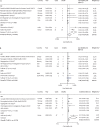Invasive group A streptococcal disease in pregnant women and young children: a systematic review and meta-analysis
- PMID: 35390294
- PMCID: PMC9217756
- DOI: 10.1016/S1473-3099(21)00672-1
Invasive group A streptococcal disease in pregnant women and young children: a systematic review and meta-analysis
Abstract
Background: The incidence of invasive disease caused by group A streptococcus (GAS) has increased in multiple countries in the past 15 years. However, despite these reports, to the best of our knowledge, no systematic reviews and combined estimates of the incidence of invasive GAS have been done in key high-risk groups. To address this, we estimated the incidence of invasive GAS disease, including death and disability outcomes, among two high-risk groups-namely, pregnant women and children younger than 5 years.
Methods: We did a systematic review and meta-analyses on invasive GAS outcomes, including incidence, case fatality risks, and neurodevelopmental impairment risk, among pregnant women, neonates (younger than 28 days), infants (younger than 1 year), and children (younger than 5 years) worldwide and by income region. We searched several databases for articles published from Jan 1, 2000, to June 3, 2020, for publications that reported invasive GAS outcomes, and we sought unpublished data from an investigator group of collaborators. We included studies with data on invasive GAS cases, defined as laboratory isolation of Streptococcus pyogenes from any normally sterile site, or isolation of S pyogenes from a non-sterile site in a patient with necrotising fasciitis or streptococcal toxic shock syndrome. For inclusion in pooled incidence estimates, studies had to report a population denominator, and for inclusion in pooled estimates of case fatality risk, studies had to report aggregate data on the outcome of interest and the total number of cases included as a denominator. We excluded studies focusing on groups at very high risk (eg, only preterm infants). We assessed heterogeneity with I2.
Findings: Of the 950 published articles and 29 unpublished datasets identified, 20 studies (seven unpublished; 3829 cases of invasive GAS) from 12 countries provided sufficient data to be included in pooled estimates of outcomes. We did not identify studies reporting invasive GAS incidence among pregnant women in low-income and middle-income countries (LMICs) nor any reporting neurodevelopmental impairment after invasive GAS in LMICs. In nine studies from high-income countries (HICs) that reported invasive GAS in pregnancy and the post-partum period, invasive GAS incidence was 0·12 per 1000 livebirths (95% CI 0·11 to 0·14; I2=100%). Invasive GAS incidence was 0·04 per 1000 livebirths (0·03 to 0·05; I2=100%; 11 studies) for neonates, 0·13 per 1000 livebirths (0·10 to 0·16; I2=100%; ten studies) for infants, and 0·09 per 1000 person-years (95% CI 0·07 to 0·10; I2=100%; nine studies) for children worldwide; 0·12 per 1000 livebirths (95% CI 0·00 to 0·24; I2=100%; three studies) in neonates, 0·33 per 1000 livebirths (-0·22 to 0·88; I2=100%; two studies) in infants, and 0·22 per 1000 person-years (0·13 to 0·31; I2=100%; two studies) in children in LMICs; and 0·02 per 1000 livebirths (0·00 to 0·03; I2=100%; eight studies) in neonates, 0·08 per 1000 livebirths (0·05 to 0·11; I2=100%; eight studies) in infants, and 0·05 per 1000 person-years (0·03 to 0·06; I2=100%; seven studies) in children for HICs. Case fatality risks were high, particularly among neonates in LMICs (61% [95% CI 33 to 89]; I2=54%; two studies).
Interpretation: We found a substantial burden of invasive GAS among young children. In LMICs, little data were available for neonates and children and no data were available for pregnant women. Incidences of invasive GAS are likely to be underestimates, particularly in LMICs, due to low GAS surveillance. It is essential to improve available data to inform development of prevention and management strategies for invasive GAS.
Funding: Wellcome Trust.
Crown Copyright © 2022 Published by Elsevier Ltd. This is an Open Access article under the CC BY 4.0 license.
Conflict of interest statement
Declaration of interests We declare no competing interests.
Figures





Comment in
-
Recognising group A streptococcal disease in pregnancy.Lancet Infect Dis. 2022 Jul;22(7):928-929. doi: 10.1016/S1473-3099(21)00745-3. Epub 2022 Apr 4. Lancet Infect Dis. 2022. PMID: 35390295 No abstract available.
-
Statistical concerns for meta-analysis of rare events and small sample sizes.Lancet Infect Dis. 2022 Aug;22(8):1111-1112. doi: 10.1016/S1473-3099(22)00364-4. Lancet Infect Dis. 2022. PMID: 35870453 No abstract available.
-
Statistical concerns for meta-analysis of rare events and small sample sizes.Lancet Infect Dis. 2022 Aug;22(8):1111. doi: 10.1016/S1473-3099(22)00363-2. Lancet Infect Dis. 2022. PMID: 35870454 No abstract available.
-
Statistical concerns for meta-analysis of rare events and small sample sizes - Authors' reply.Lancet Infect Dis. 2022 Aug;22(8):1112. doi: 10.1016/S1473-3099(22)00358-9. Lancet Infect Dis. 2022. PMID: 35870455 No abstract available.
References
-
- UNICEF Under five mortality. December, 2019. https://data.unicef.org/topic/child-survival/under-five-mortality/
-
- Fleischmann-Struzek C, Goldfarb DM, Schlattmann P, Schlapbach LJ, Reinhart K, Kissoon N. The global burden of paediatric and neonatal sepsis: a systematic review. Lancet Respir Med. 2018;6:223–230. - PubMed
-
- Liu L, Johnson HL, Cousens S, et al. Global, regional, and national causes of child mortality: an updated systematic analysis for 2010 with time trends since 2000. Lancet. 2012;379:2151–2161. - PubMed
-
- Say L, Chou D, Gemmill A, et al. Global causes of maternal death: a WHO systematic analysis. Lancet Glob Health. 2014;2:e323–e333. - PubMed
-
- Stamm WE, Feeley JC, Facklam RR. Wound infections due to group A streptococcus traced to a vaginal carrier. J Infect Dis. 1978;138:287–292. - PubMed
Uncited References
-
- Anderson BL. Puerperal group A streptococcal infection: beyond Semmelweis. Obstet Gynecol. 2014;123:874–882. - PubMed
Publication types
MeSH terms
Grants and funding
LinkOut - more resources
Full Text Sources
Medical
Miscellaneous

